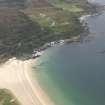Colonsay, Uragaig
Burial Ground (Early Medieval)(Possible), Chapel (Early Medieval)(Possible), Short Cist(S) (Bronze Age), Food Vessel Urn(S) (Bronze Age)
Site Name Colonsay, Uragaig
Classification Burial Ground (Early Medieval)(Possible), Chapel (Early Medieval)(Possible), Short Cist(S) (Bronze Age), Food Vessel Urn(S) (Bronze Age)
Canmore ID 37880
Site Number NR39NE 8
NGR NR 3930 9817
Datum OSGB36 - NGR
Permalink http://canmore.org.uk/site/37880
- Council Argyll And Bute
- Parish Colonsay And Oronsay
- Former Region Strathclyde
- Former District Argyll And Bute
- Former County Argyll
NR39NE 8 3930 9817.
(NR 3931 9819) Kilarow, Cill a' Rubha (J de V Loder 1935) or Cille Aroo (S Grieve 1923) - St Maelrubha's Chapel - is a small chapel attached to a burial ground in which three Bronze Age short cists been found. The site is at Uragaig on the western slope of a knoll of rock with a thin covering of soil in a grass field N of one of the crofts at the W extremity of Kiloran Bay.
The cists were excavated by W Galloway and Sir J C McNeill in 1882 but had lain partially exposed for a long time before. Each contained a crouched skeleton and the remains of an urn - in at least one case, a food vessel. Thomas (1971) suggests that this may be an example of an Early Christian burial ground imposed upon and spatially co-terminous with pre-Christian burial ground.
One of the skeletons, that of a middle-aged man, is now in the Museum of the Royal College of Surgeons, Edinburgh. It was accompanied by a flint knife or flake and what seemed to be the remains of a very open textile. An ovate enclosure, visible on RAF AP's (106G/Scot/UK 34: 3038-9, flown 1946), which could be the burial ground, occurs at NR 3931 9819 although Loder locates it to the area NR 391 982, and Grieve to area NR 391 979.
J Anderson 1907
NR 3930 9817: The oval burial ground is situated on a low knoll and measures 14.5m E-W by 10.5m within a mutilated earthen bank up to 1.5m wide and 0.5m high. The entrance is not apparent, and the disturbed interior is featureless. The cover slabs and other stones of the three cists are visible just outside the burial ground bank on the W. The largest measures 1.9m by 1.4m.
There is no trace of the alleged chapel but it could have existed in the cultivated field to the W.
Surveyed at 1:2500.
Visited by OS (DWR) 16 April 1974
See also SAS 175.
Field Visit (April 1979)
NR 393 981. In 1882 three cists were discovered at Uragaig, 120m N of Creagan farmhouse, on the w side of a knoll overlooking Kiloran Bay. The capstones of the cists are still visible and it is likely that the cists themselves remain intact beneath. This description of the excavation is unusually full for its date and the following account is a summary of the published report.
(1) This cist, covered by a massive slab (2.08m by 1.42m and up to 0.08 m thick), measured 1.17m in greatest length by 0.6m internally and 0.6m in depth and was composed of two side-slabs, overlapping the two end-slabs, and a floor slab. The crouched inhumation of a young person, probably a female, lay on its right side with the head towards the E end facing approximately to the N. A Food Vessel accompanying the burial lay in front of the face.
(2) The second was similarly constructed, with substantial slab (2.08m by 1.37m and 0.08m thick) covering a cist measuring 1-07m by 0.51m and 0.46m in depth; on the floor-slab the crouched inhumation of a male, aged about fifty, lay on its right side with the head to the E end of the cist. A fragmentary Food Vessel was discovered in front of the face, and a small flint knife was found at the pelvic region among what are described as 'the remains of a very open textile fabric'.
(3) The third cist, some 1.2m s of (1), was covered by a series of slabs and measured about 1.2m by 0.6m and 0.5m internally, with the end-slabs slightly overlapping the side slabs. The contents had been disturbed, but some small fragments of pottery were recovered.
The pottery and other finds do not appear to survive, but the skeleton from the second cist is preserved in the Museum of the Royal College of Surgeons of Edinburgh, laid out in a crouched position on the original floor-slab of the cist.
RCAHMS 1984, visited April 1979






















